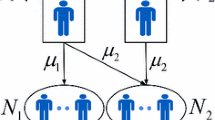Abstract
A parallel server system is considered, with I customer classes and many servers, operating in a heavy traffic diffusion regime where the queueing delay and service time are of the same order of magnitude. Denoting by \(\widehat{X}^{n}\) and \(\widehat{Q}^{n}\), respectively, the diffusion scale deviation of the headcount process from the quantity corresponding to the underlying fluid model and the diffusion scale queue-length, we consider minimizing r.v.’s of the form \(c^{n}_{X}=\int_{0}^{u}C(\widehat{X}^{n}(t))\,dt\) and \(c^{n}_{Q}=\int_{0}^{u}C(\widehat{Q}^{n}(t))\,dt\) over policies that allow for service interruption. Here, C:ℝI→ℝ+ is continuous, and u>0. Denoting by θ the so-called workload vector, it is assumed that \(C^{*}(w):=\min\{C(q):q\in\mathbb{R}_{+}^{\mathbf{I}},\theta\cdot q=w\}\) is attained along a continuous curve as w varies in ℝ+. We show that any weak limit point of \(c^{n}_{X}\) stochastically dominates the r.v. \(\int_{0}^{u}C^{*}(W(t))\,dt\) for a suitable reflected Brownian motion W and construct a sequence of policies that asymptotically achieve this lower bound. For \(c^{n}_{Q}\), an analogous result is proved when, in addition, C ∗ is convex. The construction of the policies takes full advantage of the fact that in this regime the number of servers is of the same order as the typical queue-length.
Similar content being viewed by others
References
Atar, R.: A diffusion regime with non-degenerate slowdown. Preprint
Atar, R., Gurvich, I.: Work in progress
Billingsley, P.: Convergence of Probability Measures, 2nd edn. Wiley, New York (1999)
Chen, H., Mandelbaum, A.: Leontief systems, RBVs and RBMs. In: Applied Stochastic Analysis, London, 1989. Stochastics Monogr., vol. 5, pp. 1–43. Gordon and Breach, New York (1991)
Gurvich, I.: Design and control of the M/M/N queue with multi-class customers and many servers. M.Sc. Thesis, Technion (July 2004)
Halfin, S., Whitt, W.: Heavy-traffic limits for queues with many exponential servers. Oper. Res. 29(3), 567–588 (1981)
Jacod, J., Shiryaev, A.: Limit Theorems for Stochastic Processes. Springer, Berlin (1987)
Mandelbaum, A.: QED Q’s. Notes from a lecture delivered at the Workshop on Heavy Traffic Analysis and Process Limits of Stochastic Networks, EURANDOM (September 2003)
Mandelbaum, A., Stolyar, A.L.: Scheduling flexible servers with convex delay costs: heavy traffic optimality of the generalized cμ rule. Oper. Res. 52, 836–855 (2004)
van Mieghem, J.A.: Dynamic scheduling with convex delay costs: the generalized cμ rule. Ann. Appl. Probab. 5(3), 809–833 (1995)
Whitt, W.: How multiserver queues scale with growing congestion-dependent demand. Oper. Res. 51(4), 531–542 (2003)
Author information
Authors and Affiliations
Corresponding author
Additional information
Rami Atar was supported in part by the ISF (Grant 1349/08), the US–Israel BSF (Grant 2008466), and the Technion’s fund for promotion of research.
Rights and permissions
About this article
Cite this article
Atar, R., Solomon, N. Asymptotically optimal interruptible service policies for scheduling jobs in a diffusion regime with nondegenerate slowdown. Queueing Syst 69, 217–235 (2011). https://doi.org/10.1007/s11134-011-9218-1
Received:
Revised:
Published:
Issue Date:
DOI: https://doi.org/10.1007/s11134-011-9218-1



